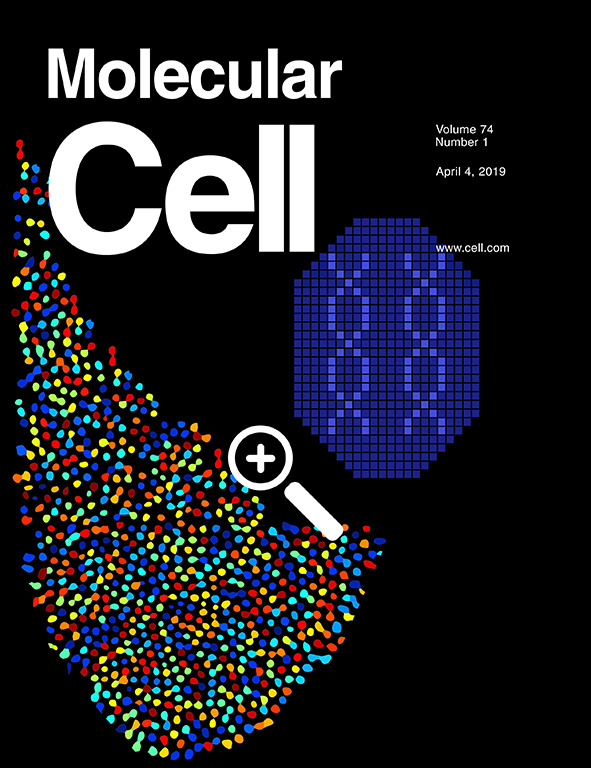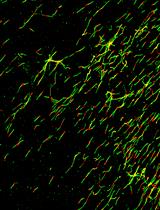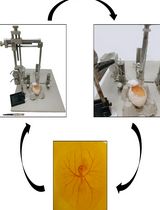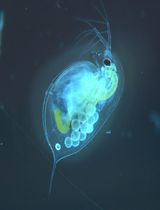- EN - English
- CN - 中文
Optogenetic Inactivation of Transcription Factors in the Early Embryo of Drosophila
果蝇早期胚胎中的光遗传失活转录因子
发布: 2019年07月05日第9卷第13期 DOI: 10.21769/BioProtoc.3296 浏览次数: 5095
评审: Imre GáspárAbhijit KalePradeep Kumar Bhaskar
Abstract
The early embryo of Drosophila melanogaster exists as a rapidly dividing syncytium of nuclei that are transcriptionally silent. Maternally deposited factors are required to awaken the genome and assist in the transition from maternal to zygotic control of development. Because many of these essential factors are maternally deposited and the early nuclear divisions are so rapid, it has been difficult to assess the functional role of transcription factors at discrete points in early embryonic development. To address this issue, we have developed an optogenetic system that can rapidly and reversibly inactivate transcription factors with nuclear-cycle resolution. The temporal precision enabled by this technique will allow a mechanistic understanding of how transcription factors function together to control genome activation and patterning in the early embryo and is likely broadly applicable to factors throughout embryogenesis.
Keywords: Optogenetics (光遗传)Background
The early embryo is transcriptionally silent and development is driven by maternally deposited mRNAs and proteins (Hamm and Harrison, 2018; Schulz and Harrison, 2019). In Drosophila, the nuclei exist in a syncytium and undergo rapid nuclear divisions, consisting only of synthesis and mitosis phases (Foe and Alberts, 1983). During the 14th nuclear cycle (NC), the genome of the developing embryo is transcriptionally up-regulated during the major wave of zygotic genome activation (ZGA) (Hamm and Harrison, 2018; Schulz and Harrison, 2019). Prior to widespread ZGA at NC14, a small subset of genes, mostly encoding transcription factors, is transcribed during a minor wave of ZGA (McDaniel et al., 2019). This entire process from egg laying to widespread ZGA takes less than three hours, which has made it technically challenging to dissect the role various transcription factors play in ZGA. Further, while genetic techniques are available to maternally deplete essential transcription factors, this removes these factors from the embryo throughout early development, making it impossible to tease apart their roles during the minor and major waves of ZGA. Other systems have used techniques like Anchor-Away or proteasome targeting to deplete nuclear proteins (Haruki et al., 2008; Caussinus et al., 2011), however, these methods take too long to inactivate their targets to work on the timescale necessary to study in the early embryo. Further, these techniques are not reversible on the timescales needed to study transcription-factor activity in the early embryo. To address these limitations, we developed an optogenetic system to rapidly and reversibly inactivate the essential transcription factor Zelda (Zld) in the early embryo of Drosophila with nuclear-cycle resolution.
Optogenetic protocols require the addition of a photo-responsive protein tag to the protein of interest, either at the endogenous locus or via a transgene. We note that both published examples of optogenetic transcription-factor inactivation in Drosophila have used an N-terminal tag, though it remains unclear if tagging at the N-terminus is required for inactivation (Huang et al., 2017; McDaniel et al., 2019). Using Cas9-mediated genome engineering, we endogenously tagged the N-terminus of Zld with the blue-light responsive CRY2 tag (McDaniel et al., 2019). CRY2, originally characterized in Arabidopsis, is traditionally part of a two-component system, where CRY2 dimerizes with CIB1 upon exposure to blue light (Liu et al., 2008). Both components are available for use in Drosophila (Guglielmi et al., 2015). However, CRY2 alone has been demonstrated to be sufficient to inactivate transcription factors, albeit through different mechanisms; CRY2-tagged Bicoid remains on chromatin upon blue-light exposure, while CRY2-tagged Zelda dissociates from chromatin (Huang et al., 2017; McDaniel et al., 2019). The mechanism of inactivation is likely a conformational change upon blue-light exposure that disrupts the ability of the transcription factor to activate transcription. One benefit of the CRY2 system is its rapidity of inactivation; upon blue-light exposure, the CRY2-tagged protein is inactivated within seconds and, when the light is removed, refolds in ~5 min (Huang et al., 2017).
While we utilized the one component CRY2 system for our experiments, this system depends on conformational changes that may be protein specific. Thus, inactivation must be confirmed experimentally. If the single-component system fails to inactivate protein function, the two-component system is available for long-term protein inactivation via cell-membrane sequestration (Guglielmi et al., 2015). In the two-component system, CRY2 will dimerize with CIB1 within seconds, but takes over an hour to dissociate once the light is removed. In Drosophila, a cell membrane localized, GFP-tagged CIB1 has been developed and could be used to sequester a target protein away from chromatin using blue-light exposure when the nuclear envelope breaks down during mitosis (Guglielmi et al., 2015). This would have a similar sequestration-mediated effect as the recently described Jabba-trap system (Seller et al., 2019). Thus, depending on experimental needs, either the one or two-component system can be used.
Here, we will describe, in detail, how to use this versatile one-component system to reversibly inactivate a protein of choice with precise temporal resolution in the early embryo of Drosophila and harvest single embryos for downstream RNA-seq.
Materials and Reagents
Note: Unless otherwise stated, materials/reagents are stored at room temperature.
- Fly husbandry and embryo selection
- Microscope Slides (25 x 75 x 1 mm) (Fisher, catalog number: 125447)
- Miracloth (Fisher, catalog number: 80058-394)
- Glass Bottom Microwell Dishes (MatTek, catalog number: P35G-1.5-14-C)
- Axygen 1.7 ml clear tubes (VWR, catalog number: 10011-722)
- Bottles, 6 oz. bottles (VWR, catalog number: 75813-108)
- Bottle plugs (VWR, catalog number: 89168-890)
- Plates; 60 x 15 mm Petri dishes (Fisher, catalog number: FB0875713A)
- Yeast (Lab Scientific, catalog number: FLY-8040-5F)
- Molasses (Lab Scientific, catalog number: FLY-8008-16)
- Bacteriological, Grade Agar (US Biological, catalog number: A0930)
- Yellow Cornmeal (Lab Scientific, catalog number: FLY-8009-20)
- p-hydroxy-benzoic acid methyl ester (Lab Scientific, catalog number: FLY-5501-5)
- Bleach (5.25% Sodium Hypochlorite) (Staples, catalog number: COX02489)
- Halocarbon oil 700 (Sigma, catalog number: H8898-50ML)
- Ethyl Acetate (Fisher, catalog number: E1964)
- Tegosept (Genesee Scientific, catalog number: 20-259)
- Molasses Food (see Recipes)
- Molasses plate (see Recipes)
- RNA extraction and purification
- Parafilm (4 in. x 250 ft.) (VWR, catalog number: 52858-032)
- Exel 27 G Hypodermic Disposable Needles (Fisher, catalog number: 148099)
- Corning Barrier Tips, 1-20 μl (Fisher, catalog number: 10320725)
- Corning Barrier Tips, 1-200 μl (Fisher, catalog number: 10320727)
- Corning Barrier Tips, 100-1,000 μl (Fisher, catalog number: 10320729)
- RNase Zap (Fisher, catalog number: AM9780)
- Trizol (Thermo Scientific, catalog number: 15596026) (store at 4 °C)
- Ultra-Pure Glycogen (Fisher, catalog number: 10814-010) (store at -20 °C)
- Chloroform (Fisher, ICN19400280)
- Isopropanol (VWR, PL323ZA-4)
- Ethanol, absolute (200 proof) (Fisher, catalog number: BP2818500)
- Fly strains
His2AvRFP (II) (Bloomington Drosophila Stock Center (BDSC) #23651) and a CRY2-tagged line with His2Av-RFP in the background. A plasmid with the CRY2 tag can be obtained from Addgene (#26866). This sequence was used to generate a CRY2-containing donor vector that was injected along with a guide RNA into w1118; PBac{y[+mDint2]=vas-Cas9}VK00027 (BDSC#51324) embryos by BestGene Inc. Edited alleles were selected using 3xP3 dsRED, and this cassette was subsequently removed. For details on the Cas9-mediated genome editing techniques used see (Hamm et al., 2017). The RFP-tagged histone was used to visualize nuclear density during each nuclear division. If the gene of interest is on the second chromosome, His2AV-RFP on the third chromosome (Bloomington Drosophila Stock Center (BDSC) #23650) can be used. It is important to independently validate all lines that you generate or receive from outside sources. We fully sequenced the CRY2-ZLD locus to ensure that the repair event happened correctly and experimentally tested two independently derived CRY2-ZLD lines to ensure that they behaved identically in all experiments. All flies were grown on standard molasses food at 25 °C in an incubator on a 12-h light/dark cycle.
Equipment
- Pipettes
- Embryo collection cage (Genesee Scientific, 59-100)
- Dissection microscope (Nikon, SMZ1000)
- Nikon ECLIPSE Ti-E epiflurescence microscope with 470 ± 20 nm and 572 ± 35 nm filters
- Embryo basket (Cantex, 5140104)
- Pellet Pestles (Fisher, catalog number: 12-141-363)
- Centrifuge
- -20 °C freezer
- -80 °C freezer
Procedure
文章信息
版权信息
© 2019 The Authors; exclusive licensee Bio-protocol LLC.
如何引用
McDaniel, S. L. and Harrison, M. (2019). Optogenetic Inactivation of Transcription Factors in the Early Embryo of Drosophila. Bio-protocol 9(13): e3296. DOI: 10.21769/BioProtoc.3296.
分类
分子生物学 > RNA > RNA 纯化
细胞生物学 > 模式生物培养 > 胚胎筛选
您对这篇实验方法有问题吗?
在此处发布您的问题,我们将邀请本文作者来回答。同时,我们会将您的问题发布到Bio-protocol Exchange,以便寻求社区成员的帮助。
Share
Bluesky
X
Copy link













